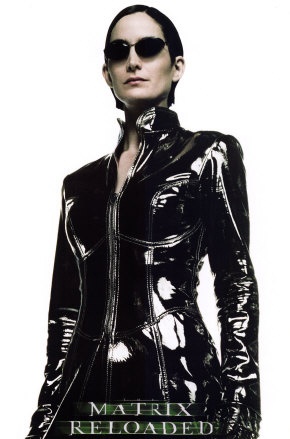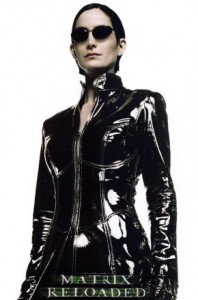
 Archival interview with Kym Barrett from the official Matrix website.
Archival interview with Kym Barrett from the official Matrix website.
BACKGROUND
MATRIX: Describe your main role on THE MATRIX sequels?
KYM: I work with Larry and Andy [Wachowski, Writers/Directors] to give the characters a real life, a real person to inhabit, and to make the actors feel comfortable being the person they’re going to portray.
MATRIX: What other films have you worked on besides THE MATRIX?
KYM: I haven’t worked on many films. My first film was Romeo + Juliet in Mexico City, which was a huge undertaking because I’d never done a film before, and we were in a foreign country and couldn’t speak the language. We’d all worked on Strictly Ballroom, but this was a big deal movie with a risk, because everyone thought no one would understand it. After that, I moved to America, and worked on commercials.
From there I did a little movie in Portland, then I did the first MATRIX, and then I went back to the US and did Red Planet, which I learnt, technically, an enormous amount from. We had to make spacesuits that really worked, that had air, that had air conditioning, that had lights, that had fan-cooling systems. We filmed some of it in Jordan in forty-eight degree heat, and then we filmed the rest of it in Coober Pedy [Australia], in a different kind of desert. I got to talk to people at NASA, people in the B2 Stealth Bomber, and to people about technology that could allow the actors to do what I wanted them to be able to do, in the sense of freedom of movement, and to have it technically believable.
 MATRIX: Which other non-film projects had you worked on before Romeo + Juliet?
MATRIX: Which other non-film projects had you worked on before Romeo + Juliet?
KYM: I’d done lots and lots of theatre, maybe eight years of theatre. In theatre you learn to do everything pretty much by yourself, with a very few dedicated people who don’t get paid very much money, so it’s a good place to start from.
MATRIX: What would you say are the key differences between film and theatre?
KYM: In theatre, you have to make sure there are a lot of things at once looking good and working, in film you get a second chance. In the theatre, the play starts and keeps on going, and if things go wrong, or things fall apart, everyone just improvises, and that’s where you get that tension and excitement. In film you get it from, I think, the intimacy of the moment, or the accuracy of the moment, because they’re focusing you on that little thing or that big thing that’s happening. Whereas in the theatre you can take your own focus, so where you focus and how you focus, you might perceive that play totally differently from somebody else. Whereas a film, emotionally you might perceive it differently, but visually what you see is focused for you. It’s all about the story for both of them, it’s all about whether you tell the story well or not.
MATRIX: You were the Costume Designer on the first film as well; how did you come to work on the film initially?
KYM: I met Bill Pope [Director of Photography] on a movie I’d been working on, and he said, “I think you’d be great for this movie, you should meet the Directors”. So I met them and they asked what I thought of the script, I said it reminded me of a Samurai movie mixed with a Western, and that’s what I grew up on. The next day they called me back and asked if I would like to do it. So it was unexpected… and an unexpectedly simple pathway.
THE ORIGINAL FILM
MATRIX: What kind of direction did the Directors give you when you first started to work out the key characters Trinity, Neo and Morpheus?
KYM: They always say, and they’ve never deviated from this, “We want it to be dark, we want it to be high contrast, we want Trinity to be like an oil slick.” They give me simple sentences and let me go away and come up with stuff, then we talk about it and it just grows. After that we make [the garment], tweak it, and it grows into things. Larry and Andy are great with allowing all of us (I think Owen [Paterson, Production Designer] would agree), they give you a little seed and then they let you expand it. Sometimes they think my ideas are ludicrous and they’ll roll around the floor laughing, then they’ll come back and say there was something there, even though it was a ridiculous idea. It’s a good way to work; it’s a very challenging and rewarding way to work.
MATRIX: Did you illustrate initially, or did you go straight to making the physical costumes?
KYM: I have found a great artist in LA who does very strong, cartoon-like drawings, but Larry and Andy work really well from textual references; they’re very visual anyway, they don’t have a problem taking a thought and visualizing it themselves. Sometimes I would say to Larry and Andy, “These are the kinds of feelings that might be, and these are the kinds of textures”, and I’ll show them the fabric. I might show them some tear sheets of rain or water or ink or something, and then go away and make the first prototype.
On one hand Larry and Andy are very broad, then on the other hand they’re very detail oriented, so they work well seeing a body and seeing how the light hits the body. The way the shape of the garment moves in the air is really important to them, and you can’t show those kind of things on a drawing. So, more often than not, they like to see a prototype of something, rather than just a drawing.
MATRIX: One of the costumes that was particularly important in the first film was the Neo coat; what lengths did you go to inorder to get it to move the way Larry and Andy wanted.
KYM: In the first movie we did quite a lot of tests on different fabrics in the air. It took a lot of things to get it to look simple; it was a matter of finding the right fabric with the right weight and combining it in the right pattern to make it move in a certain way.
MATRIX: What were some of the fabrics you used in the first film?
KYM: For Trinity [Carrie-Anne Moss] we used quite cheap PVC; we were on a much tighter budget. This time we have tried to use more sophisticated and a little bit more expensive PVCs, because there’s a broader range now, of types of PVC. We also, in certain circumstances, used patent leather, in close-ups where it doesn’t have to be stretchy, so we’d get the richness of that [on film]. Similarly, Neo’s [Keanu Reeves] coat wasn’t actually a very expensive fabric. It was a wool blend I got in New York for like three dollars a yard – but it was the perfect fabric, it did the job perfectly. But people still say to me, “What about Neo’s leather coat?” Well, he didn’t really ever have a leather coat.
MATRIX: An element of Morpheus’s costume had specially printed fabric; were there any other fabrics like that, where you went to great lengths to create?
KYM: In the original film, a lot of people were willing to do things for us that, now, they probably wouldn’t do for free or for their own experience. We did print Morpheus’s [Laurence Fishburne] coat; a company made a special plate and dyed the fabric green. They were fantastic, but of course they’re out of business now because they were too adventurous, and didn’t want to make as much money.
MATRIX: At what point did the actors for the original film step into their costume and have their input about how they felt in it?
KYM: I always think actors are involved before you even make their costume. You tell them the idea, show them the fabric, and talk about it. Luckily for us, the brothers are very involved in the costumes, so normally, if the three of us present the idea to an actor, the actor feels safe and comfortable, and will willingly try it.
A lot of costume discussion had to do with technical things like, could they do wirework in it? Could we hide a harness under it? Could it move with a fan under it and not show all the wires? So a lot of the designs came out of necessary technical problems we had to solve, and we always tried to solve them first, then made them aesthetically seamless, and hopefully at the same time made the actor feel like they had a character in there. When poor Carrie-Anne is wearing a harness and a fiberglass plate and we’re wrapping her up in PVC, it’s quite hard to convince her that she’s going to look beautiful… which of course she does.
MATRIX: What is the fiberglass plate for?
KYM: To hold her straight when she flies through the air. The actors can’t hold themselves that rigid, so we have to put in a plate that’s molded to their body shape underneath, then harness them up and put their costume over the top, so there’s a lot of lacing in and tying up. It’s not an enviable job to be Trinity at those times.
MATRIX: Do you have a favorite detail from the first film?
KYM: The good thing about this film is that they do shoot wide shots; they do shoot people head to toe. In a lot of movies, if you don’t get a little embroidery on the collar you’re done for, because they mainly shoot heads – you need to make a coffee table book to show everybody what you actually did.
In THE MATRIX we were very simple, we didn’t make anything too intricate, because the style of the movie is very ‘comic book’, it’s very sharp. The boys have certain shapes that work within their storytelling frame, and iconoclastic silhouettes that give you a certain subconscious feeling about what’s happening quickly. The Agent Smith suits, for example, basically they’re like sixties Kennedy [Secret] Service guys. In the back of your mind, subconsciously, you’ll hopefully get that, and then you can twist it around into them being evil, which makes them even more evil, and it’s a shape, as opposed to a detailed piece of fabric or a textural thing. I think the only texture we had was either matte or shiny; do they blend into a shadow, or do they shine out from a shadow? In the movie, no one else [but Trinity] wears PVC, so if we see something glistening in the dark, we know it’s her.
MATRIX: Color in THE MATRIX is important; how does that affect the costumes?
KYM: We made a rule: there is no blue in the Matrix. But in the Matrix, we do infuse almost everything with green, so even what you see as white on the screen has been through a green dye bath. If you look at our white shirts, or our grays, they’ve all had a green wash. Often you can’t tell how they’re going to grade the film in the end, so you have to give yourself a little bit of a back up, and make a decision to do things like that so there’ll always be a tinge of green. Owen and I would go to Bill and say, “This green, this green, or this green? We think this green.” And then Bill has to think ahead six months or a year, “When I’m grading this film, which green is going to be the one?” Hopefully we all choose the right one.
MATRIX: How closely do you work with Owen Paterson, the Production Designer?
KYM: We have the same pattern in our minds, and we certainly know the same colors. His red is my red, his green is my green; we know what color we’re talking about. We always have quick chats on the phone, and quick talks about things, but we don’t labor over anything. I send pictures over, he sends pictures over, and we always seem to come up with a good combination of things.
MATRIX: Thanks Kym.
Interview by REDPILL
May 2002

Be the first to comment